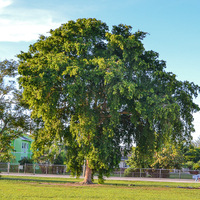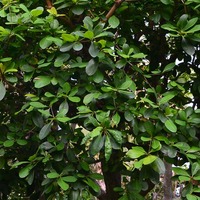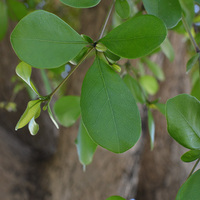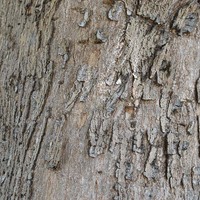Common name: Black olive
Other common names: Bullet tree, Geometry tree, Gregorywood, Olive bark tree, Wild olive
Description
Black olive is a salt-tolerant timber and landscape tree originating from Central America, the Caribbean and northern parts of South America.
It may attain heights of 25 m (80 ft) or more in its native habitat, though it is typically 10 to 15 m (30 to 50 ft) tall in cultivation with a straight trunk supporting in young trees a pyramidal, pagoda-shaped crown formed by equidistant horizontal branches. As the tree ages, the branches droop, and the crown becomes rounded.
Some varieties have sharp spines that arm the branches, while others are without spines. The bark is light grey, smooth on young trees, on older trees becoming cracked and flaking.
Leaves are small, oval, dark green and densely arranged, casting a deep shade. Although evergreen, there is steady leaf-fall throughout the year.
The flowers are creamy-white, small, but showy when abundant. They bloom fully in the middle of the dry season, with light blooms on and off over the rest of the year, followed by small, five-angled black fruit containing a single seed.
Use
Black olive is commonly cultivated in gardens, landscapes, and streetscapes, especially in coastal areas in its native region, for its attractive form, shade, and tolerance to a range of challenging growing conditions, including salt-laden winds, alkaline soils, drought and seasonal flooding.
The wood is heavy, averaging around 930 kilograms per cubic meter (58 lbs per cubic ft) and has good natural resistance to decay and termites. This makes it a durable hardwood suitable for indoor and outdoor construction.
The heartwood is yellowish to greenish-brown, with an olive hue. Large, well-formed logs are sawn either into planks for making furniture, cabinets, flooring, decking and doors or into beams for railway sleepers and heavy construction. Small diameter logs are cut for posts, poles, fencing and are sought after for making charcoal.
The flowers produce abundant nectar and are a major source for honeybees in Belize and a moderate to minor source in the Dominican Republic, Cuba, Honduras and Mexico. However, there does not appear to be much reliable information on the honey itself, its colour, taste, density or crystallisation properties.
Climate
Grows naturally in sub-humid to moderately humid tropical coastal climates, generally areas with annual lows of 19 to 25°C, annual highs of 28 to 35°C, annual rainfall of 800 to 4200 mm and a dry season of 6 months or less.
Growing
It is usually grown from vegetative parts because seed-grown trees do not always inherit the characteristics of the parent.
Performs best on free-draining clay, loam and sand soils of a slightly acid to alkaline nature, generally with a pH of 6.5 to 8.5, and on sites with full to partial sun exposure.
It has good tolerance to limestone soils, flooding, drought and salt spray, making it ideal for planting in coastal or seaside locations. Although widely cultivated as a landscape tree, it requires regular pruning to maintain an attractive shape.
Problem features
The seed float, making them easily dispersed by moving water, but there does not appear to be any records of it escaping cultivation and naturalising anywhere. It is assessed as a low weed risk species for Hawaii by the Hawaii Pacific Weed Risk Assessment (HPWRA) project.
Although evergreen, there is a steady fall of leaves all year round and the fruit exude a sticky substance that can stain sidewalks, cars and other objects. It is also prone to suckering at the base of the trunk, and the branches of some varieties are armed with sharp spines that can inflict injury.
Where it grows
References
Books
-
Adams, C. D. 1972, Flowering plants of Jamaica, University of the West Indies, Mona, Greater Kingston
-
Barwick, M., et al. 2004, Tropical & subtropical trees : a worldwide encyclopaedic guide, Thames and Hudson, London
-
Bradbear, N. 2009, Bees and their role in forest livelihoods : a guide to the services provided by bees and the sustainable harvesting, processing and marketing of their products, Food and Agriculture Organization of the United Nations (FAO), Rome
-
Chudnoff, M. 1984, Tropical timbers of the world, Forest Service, U.S. Department of Agriculture (USDA), Washington, D.C.
-
Crane, E., Walker, P. & Day, R. 1984, Directory of important world honey sources, International Bee Research Association, London
-
Fawcett, W. 1891, Economic plants, An index to economic products of the vegetable kingdom in Jamaica, Jamaica Government Printing Establishment, Kingston
-
Florida Department of Environmental Protection 2010, The Florida-Friendly Landscaping Guide to Plant Selection & Landscape Design, 1st ed., University of Florida
-
Francis, J. K. 1998, Tree species for planting in forest, rural, and urban areas of Puerto Rico, U.S. Department of Agriculture, Forest Service, International Institute of Tropical Forestry, Río Piedras, Puerto Rico
-
Francis, J. K. et al. 2000, Silvics of Native and Exotic Trees of Puerto Rico and the Caribbean Islands, Technical Report IITF-15, USDA Forest Service, Rio Piedras, Puerto Rico
-
Gilman, E. F. 1997, Trees for urban and suburban landscapes, Delmar Publishers, Albany, New York
-
Little, E. L. et al. 1964 and 1974, Common trees of Puerto Rico and the Virgin Islands (2 volumes), Forest Service, U.S. Department of Agriculture (USDA), Washington D.C.
-
Porter, T. 2012, Wood : identification & use, Compact edition, Guild of Master Craftsman Publications, Lewes, East Sussex
-
Randall, R. P. 2002, A global compendium of weeds, R.G. and F.J. Richardson Press, Melbourne
-
Rauch, F. D. & Weissich, P. R. 2000, Plants for tropical landscapes : a gardener's guide, University of Hawaii Press, Honolulu
-
Reyes, G. 1992, Wood densities of tropical tree species, U.S. Department of Agriculture, Forest Service, Southern Forest Experiment Station, New Orleans, Louisiana
-
Scheffer, T. C & Morrell, J. J. 1998, Natural durability of wood : a worldwide checklist of species, Forest Research Laboratory, Oregon State University, Corvallis, Oregon
Articles, Journals, Reports and Working Papers
-
Morton, J.F. 1964, Honeybee Plants of South Florida, Proceedings of the Florida State Horticultural Society, Vol 77:415-436.





